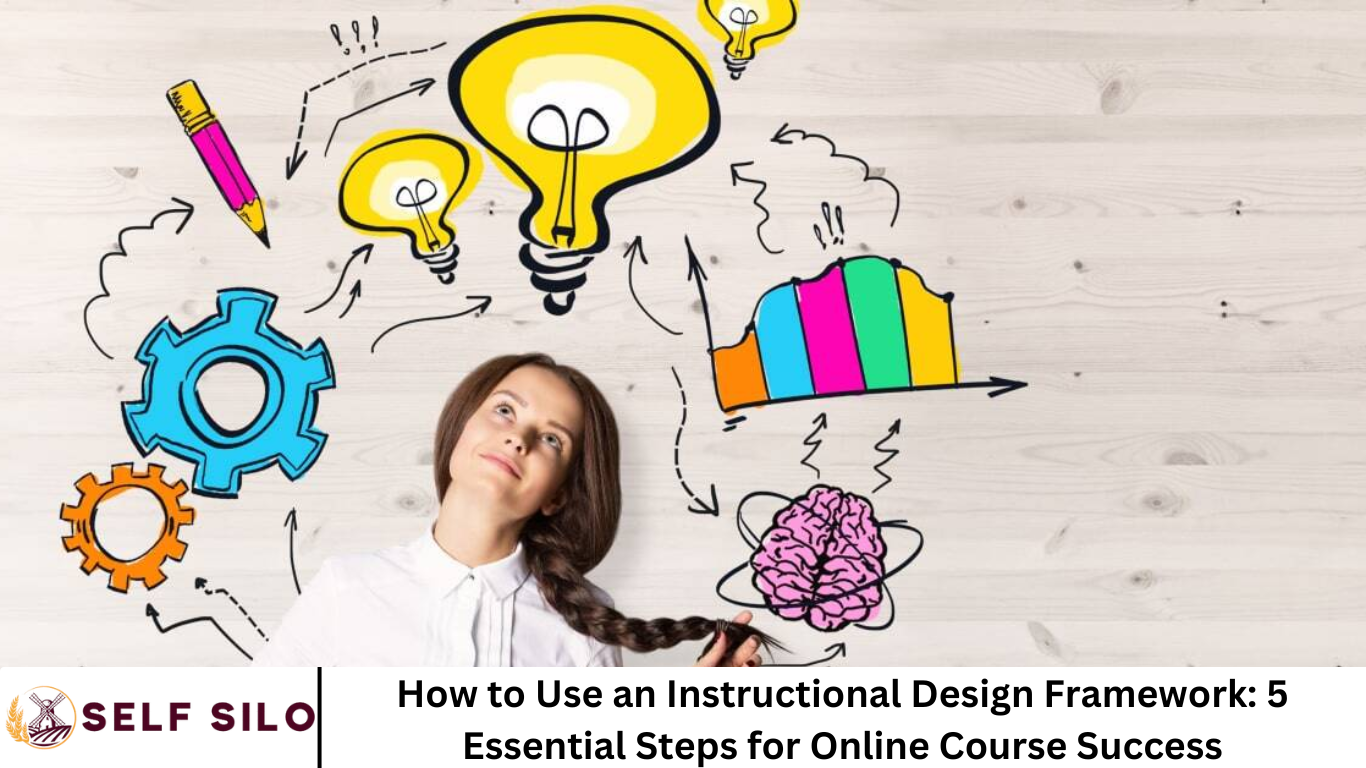Creating a successful online course goes far beyond uploading content to a learning platform. To truly engage learners and deliver measurable outcomes, you need a plan—a strategic approach that ensures your course is educationally sound, engaging, and structured for learning success. This is where instructional design frameworks come in.
We’ll walk you through five essential steps to effectively use an instructional design framework for your online course. Whether you’re a corporate trainer, educator, or online entrepreneur, this article will help you streamline course development, enhance learner outcomes, and boost course engagement.
More Read: Top 13 Online Learning Platforms to Use in 2025
What Is an Instructional Design Framework?
An instructional design framework is a systematic process used to create effective and engaging learning experiences. It offers a step-by-step guide for organizing course content, choosing instructional methods, assessing learner progress, and improving course effectiveness.
Popular instructional design models include:
- ADDIE (Analysis, Design, Development, Implementation, Evaluation)
- Backward Design
- Bloom’s Taxonomy
- Merrill’s Principles of Instruction
- SAM (Successive Approximation Model)
These frameworks serve as blueprints, helping course creators focus on learner needs while reducing wasted time and effort.
Why Use an Instructional Design Framework?
Before diving into the steps, here’s why using an instructional design framework is essential:
- Consistency: Ensures your course has logical flow and structure.
- Efficiency: Reduces trial and error by giving you a proven formula.
- Learner-Centricity: Helps align your content with learning objectives and learner needs.
- Assessment Alignment: Keeps evaluations tied directly to course goals.
- Improved Outcomes: Increases learner retention and satisfaction.
Now let’s explore how to use a framework effectively with these five essential steps.
Step 1: Analyze Learner Needs and Course Goals
Relevant Keywords: learner analysis, course objectives, audience profiling, training needs analysis
Every successful course begins with a solid understanding of your audience. The Analysis phase—especially in the ADDIE model—requires that you gather key information to inform your course design.
Key Questions to Ask:
- Who are your learners? (age, profession, skill level)
- What prior knowledge do they have?
- What challenges or pain points are they facing?
- What do they need to know or be able to do after the course?
Actions to Take:
- Conduct surveys, interviews, or assessments.
- Review existing data and learner feedback.
- Define clear, measurable learning objectives.
Pro Tip: Use tools like Google Forms or Typeform to easily collect data from your target audience. This will guide your content and ensure relevancy.
Step 2: Design the Course Structure and Learning Path
Relevant Keywords: course outline, instructional strategies, curriculum design, learning path
With your audience and goals clearly defined, the next step is Design—mapping out how learners will achieve the desired outcomes.
Key Elements to Include:
- Course outline with modules and lessons
- Instructional strategies (e.g., video, case studies, simulations)
- Delivery format (self-paced, blended, cohort-based)
- Assessment plan (quizzes, projects, discussions)
Instructional Best Practices:
- Use Bloom’s Taxonomy to design objectives and activities that promote higher-order thinking.
- Sequence content from simple to complex.
- Scaffold learning to build on previous knowledge.
Example:
If your goal is to teach digital marketing, your course might include:
- Intro to Marketing Concepts
- Understanding SEO and Analytics
- Creating a Campaign Plan
- Running Ads and Measuring ROI
Pro Tip: Use tools like Miro or Notion to map out your course visually before creating any content.
Step 3: Develop Engaging and Accessible Content
Relevant Keywords: content development, multimedia learning, interactive course design, accessible eLearning
Now it’s time to build the course materials. This is the Development phase, where your design comes to life through actual lessons, videos, worksheets, quizzes, and other resources.
Content Types to Consider:
- Videos and animations for visual learners
- Interactive modules (drag-and-drop, clickable scenarios)
- Downloadable PDFs, cheat sheets, or templates
- Audio files or podcasts
- Discussion forums or live sessions
Make It Engaging:
- Break long content into microlearning chunks.
- Include frequent checkpoints or knowledge checks.
- Use real-life examples and storytelling to increase relatability.
Ensure Accessibility:
- Add captions to videos
- Use screen-reader friendly formats
- Choose readable fonts and high-contrast colors
Pro Tip: Use eLearning authoring tools like Articulate Rise, Canva, or Adobe Captivate to create professional content quickly.
Step 4: Implement and Launch the Course
Relevant Keywords: LMS integration, course launch, beta testing, learner onboarding
Once your content is ready, it’s time to implement your course. This includes choosing the right Learning Management System (LMS), uploading your content, and getting everything ready for learners.
Key Steps:
- Select a platform (e.g., Teachable, Thinkific, Moodle)
- Upload and organize modules
- Set up user access and permissions
- Test all links, media, and interactions
- Plan your launch strategy (email campaign, social media, etc.)
Run a Pilot:
Before a full launch, consider a beta test with a small group of learners. Gather feedback on usability, content clarity, and engagement.
Pro Tip: Use automated onboarding emails to help learners navigate the course and stay motivated.
Step 5: Evaluate and Continuously Improve
Relevant Keywords: course evaluation, learner feedback, course analytics, instructional improvement
The final step—and one often overlooked—is Evaluation. Effective instructional design is iterative. Use data and feedback to continuously improve your course.
Evaluate With:
- Learner surveys
- Quiz and assessment results
- Completion and drop-off rates
- Discussion participation
- LMS analytics
Key Questions to Ask:
- Did learners achieve the intended outcomes?
- Which modules had the most engagement?
- Where did learners struggle or disengage?
Make Improvements:
- Refine confusing content
- Add more interactive elements
- Re-sequence lessons for better flow
- Update or add new examples based on feedback
Pro Tip: Schedule regular course reviews every 3–6 months to keep your content fresh and effective.
Bonus: Choosing the Right Instructional Design Model
While this article uses the ADDIE model for structure, other models may better suit your needs:
- Backward Design: Great for outcome-driven courses.
- SAM (Successive Approximation Model): Ideal for agile course creation and iteration.
- Merrill’s Principles of Instruction: Focused on problem-based learning and real-world application.
Choose the model that aligns best with your goals, team size, timeline, and audience.
Frequently Asked Question
What is an instructional design framework?
An instructional design framework is a structured approach used to plan, develop, and evaluate educational programs. It guides course creators through essential steps like analyzing learner needs, designing learning objectives, developing content, implementing the course, and evaluating outcomes.
Why should I use an instructional design framework for my online course?
Using a framework ensures your course is goal-oriented, learner-focused, and organized. It saves time, reduces guesswork, improves learner engagement, and helps deliver measurable learning outcomes.
Which instructional design model is best for online courses?
The ADDIE model is one of the most popular and versatile models, ideal for both beginners and advanced designers. Other effective models include Backward Design, SAM (Successive Approximation Model), and Merrill’s Principles of Instruction—each with unique strengths depending on your course goals and audience.
How do I start the course design process using a framework?
Begin with the Analysis phase, where you identify your learners’ needs, skill levels, and course objectives. This foundational step sets the direction for your content, assessments, and instructional methods.
What are the five essential steps to follow?
The five essential steps are:
- Analyze learner needs and course goals
- Design the course structure and instructional strategy
- Develop engaging and accessible content
- Implement and launch the course on a suitable platform
- Evaluate results and make continuous improvements
How do I know if my course is effective?
You can evaluate effectiveness through:
- Learner feedback and surveys
- Completion and drop-off rates
- Quiz and test performance
- Course analytics and engagement metrics
- Achievement of learning outcomes
Can I use a design framework even if I’m not a professional instructional designer?
Absolutely! Instructional design frameworks are meant to simplify course creation for everyone, including entrepreneurs, educators, and corporate trainers. Even without formal training, following a structured approach will help you create more polished and impactful courses.
Conclusion
Using an instructional design framework is one of the most effective ways to build high-quality online courses that truly support learner success. By following the five essential steps—analyze, design, develop, implement, and evaluate—you bring structure, clarity, and purpose to your course creation process. Whether you’re launching your first course or refining an existing one, a solid framework helps ensure that every piece of content aligns with your learning goals and meets the needs of your audience. The result? A course that is not only engaging and professional but also delivers measurable results.


